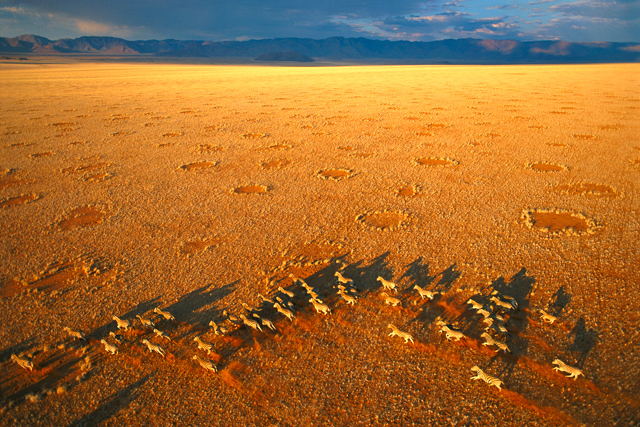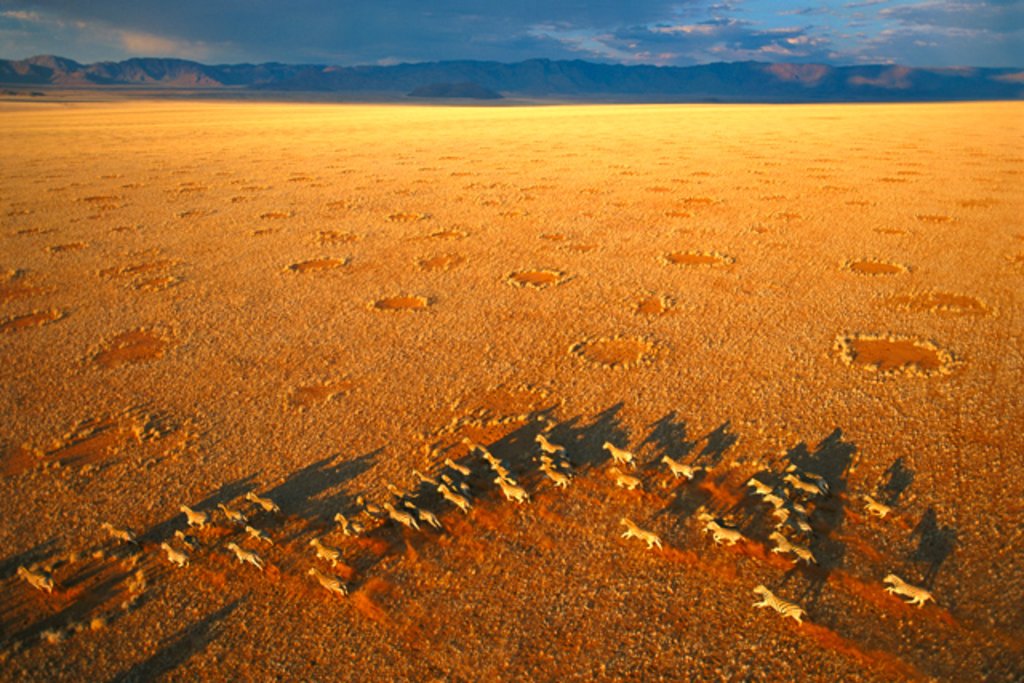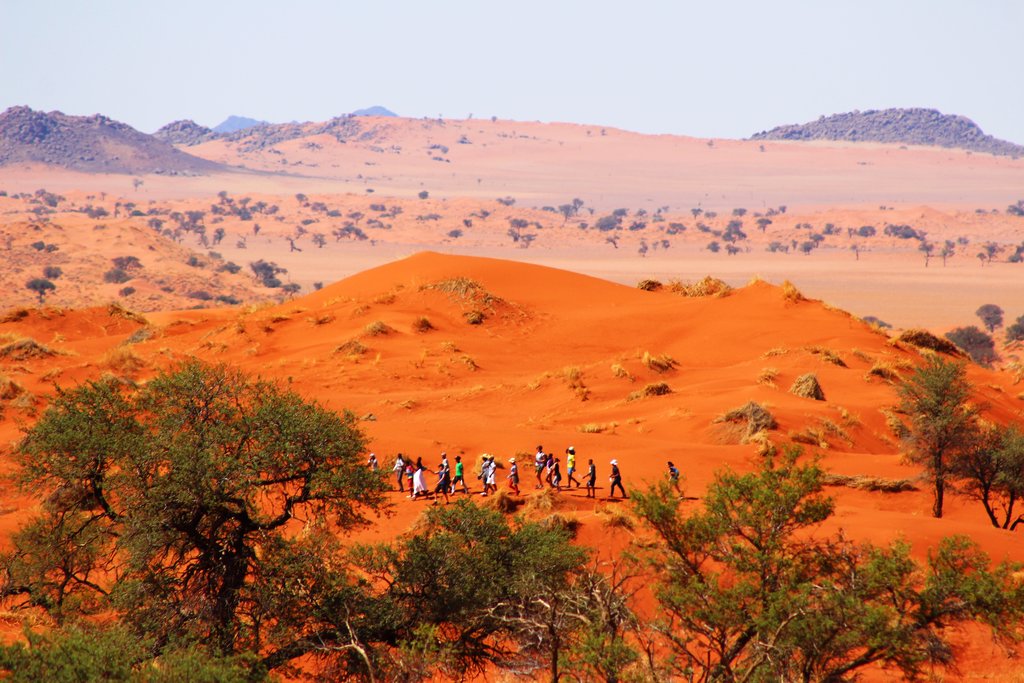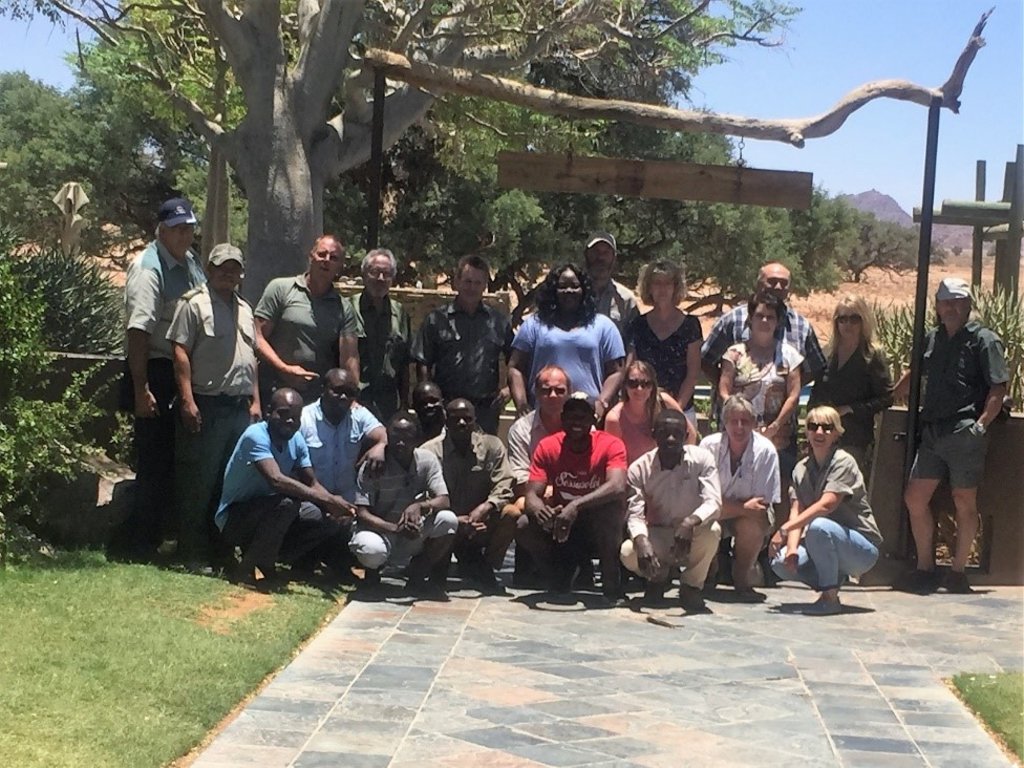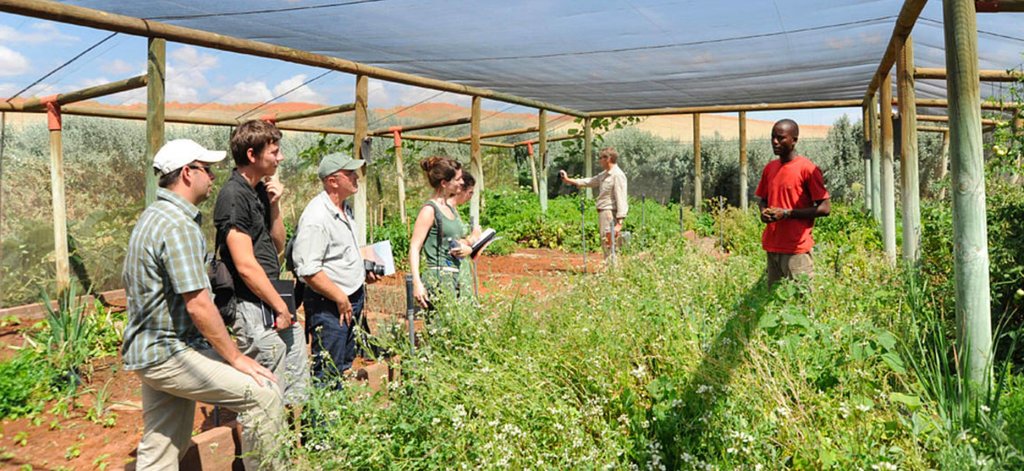Restoration of game migration routes across the Namib Desert [纳米比亚]
- 创建:
- 更新:
- 编制者: Ibo Zimmermann
- 编辑者: –
- 审查者: Rima Mekdaschi Studer, Simone Verzandvoort
NamibRand Nature Reserve
approaches_3286 - 纳米比亚
- Restoration of game migration routes across the Namib Desert: Nov. 2, 2021 (public)
- Restoration of game migration routes across the Namib Desert: Oct. 6, 2018 (inactive)
- Restoration of game migration routes across the Namib Desert : April 13, 2018 (inactive)
- Restoration of game migration routes across the Namib Desert : Feb. 23, 2018 (inactive)
- Restoration of game migrations across Namib Desert: Jan. 12, 2018 (inactive)
查看章节
全部展开 全部收起1. 一般信息
1.2 参与方法评估和文件编制的资源人员和机构的联系方式
有助于对方法进行记录/评估的项目名称(如相关)
NamibRand Nature Reserve有助于对方法进行记录/评估的机构名称(如相关)
Namibia University of Science and Technology ( NUST) - 纳米比亚1.3 关于使用通过WOCAT记录的数据的条件
(现场)数据是什么时候汇编的?:
01/11/2017
编制者和关键资源人员接受有关使用通过WOCAT记录数据的条件。:
是
2. SLM方法的描述
2.1 该方法的简要说明
Seventeen former sheep farms have been joined to form the world’s largest private nature reserve aimed at regenerating biodiversity to support high-quality low-impact tourism, environmental education and research. All farm owners are members of the management association.
2.2 该方法的详细说明
该方法的详细说明:
The NamibRand Nature Reserve is a not-for-profit organisation in south-western Namibia. It was founded in 1984 through the initiative of one farm owner, Albi Brueckner, who agreed, with 16 neighbouring farmers, to jointly manage their 215,000 ha for nature conservation and tourism. Its aims are:
To conserve biodiversity for the benefit of future generations and protect the sensitive and fragile environment.
To create a nature reserve with a healthy and functioning ecosystem, providing a sanctuary for flora and fauna, and to facilitate seasonal migratory routes in partnership with neighbours.
To promote sustainable utilisation – through ecologically sustainable and high-quality tourism and other projects.
To achieve a commercially viable operation to ensure continuity and financial independence.
The NamibRand Nature Reserve’s contributions to biodiversity conservation, in accordance with the environmental management plan, include the following:
• Removal of over 2,000 km of fencing to reinstate wildlife migration routes.
• Re-introduction of giraffe and cheetah.
• Bolstering numbers of red hartebeest and plains zebra.
• Removal of alien invasive vegetation such as Prosopis species and replacing these with indigenous Acacias.
• Zonation according to land use areas, including the setting aside 15% of the reserve as a wilderness area.
• Limiting overnight visitors to an average of one bed per 1,000 ha, and 25 beds per location.
• Conducting annual game counts, with results posted on the website www.namibrand.org
• Monitoring the endemic Hartmann’s mountain zebra through the use of camera traps. Results are at: http://www.nnf.org.na/project/mountain-zebra-project/13/1/12.html
• Continuous monitoring of drivers and determinants of environmental change to guide the management plan. Results are posted online at: http://www.landscapesnamibia.org/sossusvlei-namib/rainfall-monitoring
• Hosting researchers to study game migration routes. Results of wildlife monitoring, through the use of GPS collars are at: http://www.landscapesnamibia.org/sossusvlei-namib/research
• Hosting the Namib Desert Environmental Education Trust (NaDEET), to empower and educate schoolchildren for a sustainable future. It operates an environmental education and sustainable living centre (www.nadeet.org).
• A lighting management plan to qualify as an international dark sky reserve that avoids negative consequences of light pollution on biodiversity – which can interfere with animal navigation, reduce the hunting success of predators and prevent moths from pollinating (http://www.darksky.org/idsp/reserves/namibrand)
• A water management plan, including monitoring of the impact of a water hole on the surrounding vegetation.
• Implementation of tourism and land use zonation plans.
• Capture and sale of live game for wildlife population management purposes.
• Plans to develop a horticultural project to grow indigenous medicinal plants for commercial production, creating local jobs and income for conservation.
Rangeland management is achieved largely through continual monitoring and control of animal populations, and the balance between functional groups of their species, and turning off the water supply where grasses are in need of rest. Local outreach efforts focus mainly on predator-livestock management on neighbouring farms.
Stakeholders comprise the land owners, who agree on joint management, and the tourism concessionaires who operate in the reserve under contract. The reserve employs 12 people who are responsible for day-to-day management and maintenance. Biodiversity and land management are funded from park fees collected by the concessionaires from tourists who stay at their establishments. This small management team is possible, because tourism concessionaires offer scenic game drives across the reserve, while on the lookout for required action. For example, guides report issues such as leaking water pipes, unusual wildlife sightings, injured animals, and trespassers (etc.) to reserve managers, who can then react.
Land owners who have connected their land to the reserve and are members of the NamibRand Nature Reserve Association have the option of serving as directors of the association, with joint decision making powers. Those who choose not can still contribute to the strategic mission of the reserve at annual general meetings.
2.3 该方法的照片
2.4 该方法的视频
注释、简短说明:
Short introduction to the reserve
https://www.youtube.com/watch?v=QVQgJlBXn78
日期:
01/04/2015
位置:
NamibRand Nature Reserve
摄影师的名字:
IUCN-PAPACO
注释、简短说明:
View of landscapes in the reserve
https://www.youtube.com/watch?v=8LZI2ZtPhbg
日期:
15/09/2014
位置:
NamibRand Nature Reserve
摄影师的名字:
Christine Guillot, Etendues Sauvages
注释、简短说明:
Organic garden at lodge in the reserve
https://www.youtube.com/watch?v=U7RVKfeQ-0M
日期:
05/04/2016
位置:
NamibRand nature Reserve
摄影师的名字:
Ticket2Utopia – Dr. Paul Goddard
2.5 采用该方法的国家/地区/地点
国家:
纳米比亚
区域/州/省:
Southwestern Namibia in the Namib Desert.
Map
×2.6 该方法的开始和终止日期
注明开始年份:
1984
若不知道准确的年份,请注明该方法的大致开始日期。:
10-50年前
注释:
The first property was purchased in 1984. The reserve was registered as a Game Reserve in 1992 and registered as the NamibRand Nature Reserve, an Association Not for Gain, in 2002
2.7 方法的类型
- 最近的本地倡议/创新
2.8 该方法的主要目的/目标
The approach aims, through participatory land use planning, to restore ecosystem function in the reserve and its surroundings to support high-quality, low-impact tourism that provides the means to support environmental education and other conservation projects.
The overall Strategic Vision of the NamibRand Nature Reserve is to manage the Pro-Namib area, alongside the Namib Desert, for the enhanced conservation of the landscape and its biodiversity.
2.9 推动或妨碍实施本办法所适用的技术的条件
社会/文化/宗教规范和价值观
- 启动
The area was historically visited by migrant San people and more recently by Nama people, who have settled permanently elsewhere. Since no people were living permanently in this hyper-arid ecosystem, the use of the area exclusively for nature conservation remains uncontested.
财务资源和服务的可用性/可得性
- 启动
The establishment of the reserve was initially possible through the ample financial resources of wealthy, altruistic and philanthropic investors.
- 阻碍
The properties that make up the NamibRand Nature Reserve are located in a hyper-arid ecosystem. Farmers who attempted livestock farming there in the past almost all failed to establish economically viable farms, and most of them overextended themselves financially, resulting in the foreclosure of their farms. For this reason, the area became known as the “Bankruptcy Belt”. Banks were, in the past, extremely reluctant to extend loans to landowners in this area, due to the low value and low agricultural potential. In recent years, the successes of conservation and tourism have changed this situation and banks are now prepared to accept farms with such land use as collateral for extending loans.
机构设置
- 启动
Progressive government company laws, such as the possibilit y to register a Section 21 company (“Association Not for Gain”) allow financial resources to be re-invested in conservation so as to further the objectives of the non-profit association. Section 21 companies also do not have to pay company taxes to the government.
参与者的的协作/协调
- 启动
Articles of Association and the management plan allow for the creation of a management team that effectively coordinates all activities on the reserve.
法律框架(土地使用权、土地和水使用权)
- 启动
Rights and therefore the possibility to benefit from wildlife are enshrined in the Nature Conservation Ordinance of 1975.
- 阻碍
The current Nature Conservation Ordinance of 1975 does not allow for the registration of private nature reserves. The status of the land with the government thus remains as agricultural land, and law enforcement has to rely on common law such as trespassing on private property.
政策
- 启动
Progressive, enabling policies of the Ministry of Environment and Tourism, such as the tourism policy and the parks and neighbours policy ensure meaningful collaborations between the public and the private sector. See http://www.met.gov.na
土地治理(决策、实施和执行)
- 启动
Good governance is achieved through the adoption of Articles of Association and management plans. These guide decision-making and enable implementation. A set of rules, called the Vade Mecum, enable enforcement.
了解SLM,获得技术支持
- 启动
Good networking, membership to various professional bodies and collaboration with universities and researchers ensure good knowledge about sustainable land management and technical support.
市场(购买投入,销售产品)和价格
- 启动
A well-established tourism market to Namibia ensures a steady stream of visitors to the NamibRand Nature Reserve, enabling the collection of park fees and thus ensuring income for the reserve.
- 阻碍
The remoteness of the reserve, 150km from the nearest town, results in expensive transport charges for goods and inflated prices for professional services.
工作量、人力资源可用性
- 启动
Guides from tourism concessions on the reserve allow for sharing of workloads. Availability of human resources in the region is ample.
3. 相关利益相关者的参与和角色
3.1 该方法涉及的利益相关者及其职责
- 当地土地使用者/当地社区
17 former livestock farms owned by 12 companies, now converted to tourism enterprises
Some of them serve as directors of the NamibRand Nature Reserve Association, for joint decision making
- SLM专家/农业顾问
12 reserve management staff
To manage the reserve
- 研究人员
Visiting researchers from various academic institutions
To conduct research to help with applied research for management and "interest research" such as on “fairy circles”, which can be seen in the cover photo. The origin of these circles of bare soil surrounded by grass is still being disputed among scientists (https://www.youtube.com/watch?v=2VNyo9AoA8I). There is a Wildlife monitoring programme partnership with Namibia University of Science and Technology and the Greater Sossusvlei Landscape Association
- 教师/学龄儿童/学生
4 full-time teachers at NADEET and 10 instructors at hospitality training centre.
To expose about 1000 visiting students per year to environmental education and to provide vocational training to about 100 trainees per year.
- NGO
Cheetah Conservation Fund and Giraffe Conservation Fund.
To reintroduce predators and wild herbivore species.
- 私营部门
Neighbouring farms
Co-management of the larger landscape with like-minded neighbours, as indicated at: http://www.landscapesnamibia.org/sossusvlei-namib/
- 国家政府(规划者、决策者)
Ministry of Environment and Tourism.
To assist with law enforcement and wildlife monitoring.
- 国际组织
Member of IUCN
For advocacy and knowledge sharing.
3.2 当地土地使用者/当地社区参与该方法的不同阶段
| 当地土地使用者/当地社区的参与 | 指定参与人员并描述活动 | |
|---|---|---|
| 启动/动机 | 自我动员 | The founding farm owner approached philanthropic donors to buy neighbouring farms and invest in tourism facilities and environmental education centre. |
| 计划 | 外部支持 | In 1991, external experts provided advice for planning of the reserve. Influential persons involved included Chris Brown, Hugh Berry and Haino Rumpf of the Ministry of Environment, and Mary Seely of the Desert Research Foundation. |
| 实施 | 自我动员 | Management staff were appointed in 1991, and paid for from the conservation levy raised from use of tourism facilities in the reserve. |
| 监测/评估 | 自我动员 | Reserve management staff do the monitoring, paid for by the conservation levy. |
| research | 外部支持 | Research institutions conduct research after paying a small service fee. |
3.4 有关SLM技术选择的决策
具体说明谁有权决定选择要实施的技术:
- 主要是土地使用者,由SLM专家提供支持
解释:
The Reserve's vision and mission were set up by its directors, who comprise farm owners willing to serve in this decision making role, at the Initiation workshop in 1991. Management actions were then Implemented under the guidance of various specialists.
明确做出决策的依据:
- 对充分记录的SLM知识进行评估(基于证据的决策)
- 研究结果
- 个人经验和意见(无记录)
4. 技术支持、能力建设和知识管理
4.1 能力建设/培训
是否为土地使用者/其他利益相关者提供培训?:
是
明确受训人员:
- 土地使用者
- 现场工作人员/顾问
- Tourism concessionaires
培训形式:
- 在职
- 示范区域
- 公开会议
培训形式:
- Exchange visits
涵盖的主题:
Biodiversity conservation, financial management, tourism best practices, principles of co-management, human-wildlife conflict resolution, rehabilitation.
4.2 咨询服务
土地使用者有权使用咨询服务吗?:
是
指明是否提供了咨询服务:
- 在土地使用者的土地上
- 在固定中心
说明/注释:
Advice is provided by the Namibia Chamber of Environment, the Namibia Nature Foundation, the Ministry of Environment and Tourism Resource Centre, the Namibia University of Science and Technology, the Giraffe Conservation Fund and other wildlife biologists on issues such as determination of wildlife carrying capacities.
4.3 机构强化(组织发展)
是否通过这种方法建立或加强了机构?:
- 是,非常
具体说明机构的强化或建立程度:
- 本地
说明机构、角色和职责、成员等。:
NamibRand Nature Reserve Association. All land owners are members, who elect the directors. They manage the reserve according to an agreed strategy.
具体说明支持类型:
- 财务
提供进一步细节:
Hiring of lawyers and auditors/accountants to establish the association.
4.4 监测和评估
监测和评估是该方法的一部分吗?:
是
注释:
Impacts are monitored to feed back into management.
若是,该文件是否用于监测和评估?:
否
4.5 研究
研究是该方法的一部分吗?
是
明确话题:
- 生态学
提供进一步的细节,并指出是谁做的研究:
Determination of wildlife carrying capacities by wildlife biologists.
5. 融资和外部物质支持
5.1 该方法中SLM组成部分的年度预算
如果不知道准确的年度预算,请给出一个范围:
- 100,000-1,000,000
注释(例如主要的资助来源/主要捐助者):
Self funded from conservation levy collected from tourism income.
5.2 为土地使用者提供财政/物质支援
土地使用者是否获得实施该技术的财政/物质支持?:
否
5.4 信用
是否根据SLM活动的方法给予信用值?:
否
5.5 其它激励或手段
是否有其他激励措施或工具用于促进SLM技术的实施?:
否
6. 影响分析和结论性陈述
6.1 方法的影响
该方法是否有助于当地土地使用者,提高利益相关者的参与度?:
- 否
- 是,很少
- 是,中等
- 是,支持力度很大
Interest in owning land has greatly increased. Land prices have risen and more tourism establishments were built.
这种方法是否有助于基于证据的决策?:
- 否
- 是,很少
- 是,中等
- 是,支持力度很大
Through monitoring, to determine wildlife carrying capacity.
该方法是否帮助土地使用者实施和维护SLM技术?:
- 否
- 是,很少
- 是,中等
- 是,支持力度很大
Research and expert advice drives appropriate management for the ecology. There are no more sheep and associated weeds, while wildlife numbers increased.
该方法是否提高了SLM的协调性和成本效益?:
- 否
- 是,很少
- 是,中等
- 是,支持力度很大
By applying economies of scale. Managed holistically by a small, effective team.
该方法是否调动/改善了使用财务资源实施SLM的途径?:
- 否
- 是,很少
- 是,中等
- 是,支持力度很大
Through awarding of tourism concessions and collection of park fees.
该方法是否提高了土地使用者实施土地管理的知识和能力?:
- 否
- 是,很少
- 是,中等
- 是,支持力度很大
Through various training and research activities.
该方法是否提高了其他利益相关者的知识和能力?:
- 否
- 是,很少
- 是,中等
- 是,支持力度很大
Through accessing information and gaining knowledge from research.
该方法是否建立/加强了机构、利益相关者之间的合作?:
- 否
- 是,很少
- 是,中等
- 是,支持力度很大
Through establishment of the association, appointment of the management team and information sharing.
该方法是否缓解了冲突?:
- 否
- 是,很少
- 是,中等
- 是,支持力度很大
Through implantation of a joint management plan and shared vision.
该方法是否有助于社会和经济弱势群体?:
- 否
- 是,很少
- 是,中等
- 是,支持力度很大
There are no local communities living within the area, but children from all over the country visit the environmental education centre.
该方法是否改善了性别平等并赋予女性权力?:
- 否
- 是,很少
- 是,中等
- 是,支持力度很大
Through policies prohibiting gender discrimination, implemented by tourism enterprises.
该方法是否鼓励年轻人/下一代土地使用者参与SLM?:
- 否
- 是,很少
- 是,中等
- 是,支持力度很大
Through the environmental education and vocational training centres.
该方法是否改善了阻碍SLM技术实施的土地使用权/用户权问题?:
- 否
- 是,很少
- 是,中等
- 是,支持力度很大
Through establishment of the Association for joint management and guidelines that are followed in the management plan.
该方法是否改善了粮食安全/改善了营养?:
- 否
- 是,很少
- 是,中等
- 是,支持力度很大
Through the organic garden of 1 ha irrigated with borehole water and featuring in one of the Youtube videos, the improved financial status of the area and access to meat of culled animals for reserve workers and tourists.
该方法是否改善了市场准入?:
- 否
- 是,很少
- 是,中等
- 是,支持力度很大
Due to serving tourism needs.
该方法是否改善了供水和卫生条件?:
- 否
- 是,很少
- 是,中等
- 是,支持力度很大
Workers have access to borehole water pumped for tourism.
该方法是否带来了更可持续的能源使用?:
- 否
- 是,很少
- 是,中等
- 是,支持力度很大
Solar power is used to generate electricity and heat water.
该方法是否提高了土地使用者适应气候变化/极端情况和减轻气候相关灾害的能力?:
- 否
- 是,很少
- 是,中等
- 是,支持力度很大
Based on naturally adapted species that are able to migrate.
该方法是否会带来就业、收入机会?:
- 否
- 是,很少
- 是,中等
- 是,支持力度很大
The current land use based on tourism supports times more employees per unit area compared with former sheep farming.
National economy:
- 否
- 是,很少
- 是,中等
- 是,支持力度很大
Contribution to national income through higher wages in the tourism industry.
6.2 土地使用者实施SLM的主要动机
- 增加利润(能力),提高成本效益比
Through tourism, compared with former sheep farming.
- 减少土地退化
Reliance on more appropriate land use.
- 降低灾害风险
Nature takes better care of itself and is more resilient to drought than sheep farming was.
- 减少工作量
Sheep herders are no longer needed and there is a small, efficient management team, assisted by information provided through tour guides when their attention is required.
- 声望、社会压力/社会凝聚
Through membership of the association.
- 环境意识
Forms the vision of the association.
- 提高SLM知识和技能
Improved resource management due to expert knowledge.
- 美学改进
There are rules to prevent unsightly buildings and maintain the clear night sky, free from light pollution.
- 冲突缓解
Through the association constitution and discussions at planning meetings working towards the common goal
- Philantropic
Wanting to do good and contribute to conservation.
6.3 方法活动的可持续性
土地使用者能否维持通过该方法实施的措施(无外部支持的情况下)?:
- 是
若是,请说明如何维持:
Through income largely derived from tourism and partly from sale of captured game animals in accordance with the environmental management plan.
6.4 该方法的长处/优点
| 土地使用者眼中的长处/优势/机会 |
|---|
| The reserve is centrally and holistically managed by a team. |
| Resilience attained by the large unfenced ecosystem. |
| Land users coming together to sign and form a legally recognised body that is more robust. |
| Tourism is more profitable and sustainable than agriculture for such a hyper arid region. |
| 编制者或其他关键资源人员认为的长处/优势/机会 |
|---|
| Resilience to climate change through natural resources, using the competitive advantage of nature. |
| Private property excludes communal demands and allows fast and easy decision making on land use. |
6.5 该方法的弱点/缺点以及克服它们的方法
| 土地使用者认为的弱点/缺点/风险 | 如何克服它们? |
|---|---|
| There is currently no legislative support from government for protection of private land. | The new wildlife bill being drafted makes provision for privately protected areas. |
| In the eyes of the Ministry of Lands, there are only two types of land, either urban and gazetted (e.g. parks) or agricultural (subject to land tax). | Include a third category of land for protected areas, such as the desert margin being non-agricultural. |
7. 参考和链接
7.1 方法/信息来源
- 与土地使用者的访谈
Chief Executive Officer of the NamibRand Nature Reserve
7.2 参考可用出版物
标题、作者、年份、ISBN:
A Guidebook to the NamibRand Nature Reserve, 2017, ISBN 978-99945-85-14-4
可以从哪里获得?成本如何?
Local bookshops for approximately USD25
7.3 链接到网络上可用的相关信息
标题/说明:
Website of NamibRand Nature Reserve
URL:
www.namibrand.org
标题/说明:
Website of Namib Desert Environmental Education Trust
URL:
www.nadeet.org
链接和模块
全部展开 全部收起链接
无链接
模块
无模块


